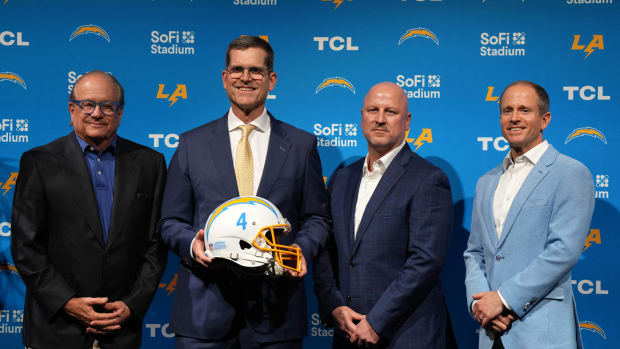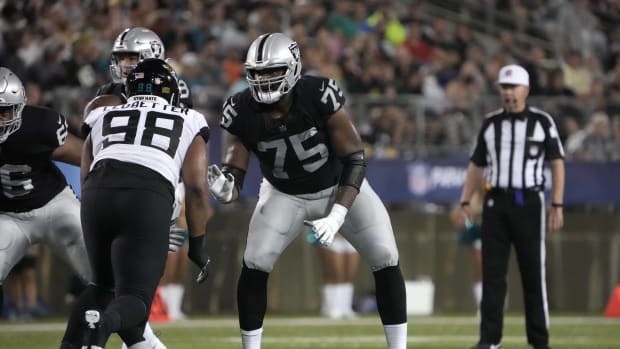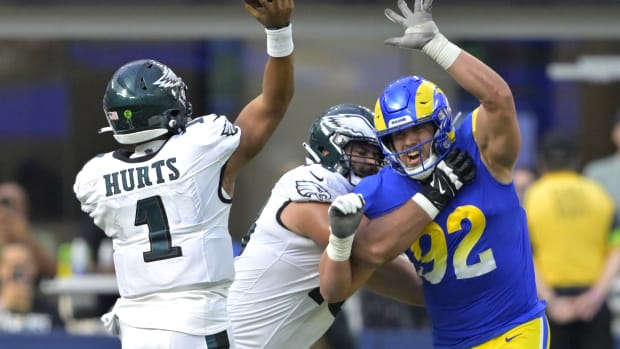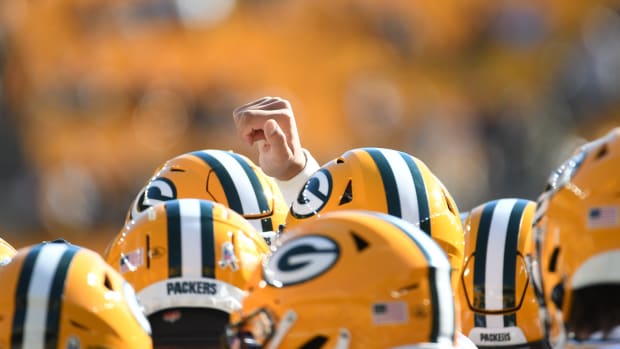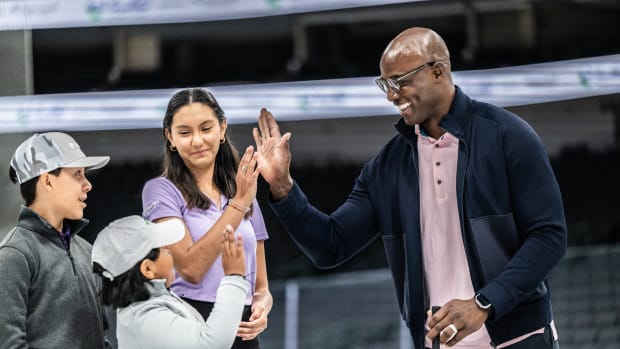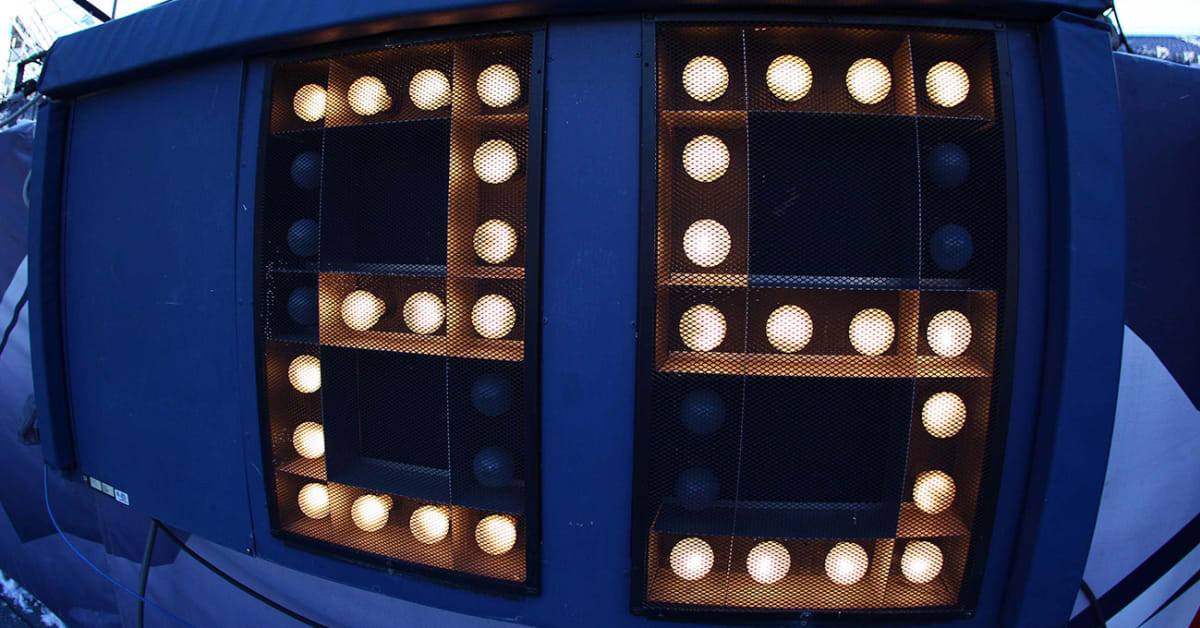
The NFL Should Abolish the Play Clock in Favor of a Better System
Welcome to Bad Takes Week, where MMQB staffers have been asked to expand upon some of their worst football takes. Keep an eye out for more of these throughout the week, and every story is posted here.
Sometimes I wonder what the NFL would look like if everybody were not in such a perpetual rush. Line up here, place the ball there, watch two clocks at the same time, run on and off the field ASAP … sometimes football seems like a game between two groups of people who can’t find their keys.
But what if it weren’t? What if we simplified the clock rules to the point where they were easier to follow—and more effective?
I don’t think people realize how much the clock negatively influences the game. In the 2022 regular season, there were 159 delay-of-game penalties—the fifth-most of any penalty type. There were another 92 penalties that were likely a result of players rushing to beat the clock: for the offense having too many men on the field, illegal formations, illegal shifts and illegal substitutions. Then there were all the timeouts burned to avoid delay-of-game penalties. Nothing in this paragraph adds to anybody’s enjoyment of the game.
My solution is two-pronged.
First: The game clock would start when the ball is placed on the line of scrimmage, pause momentarily when the play ends, and restart when the ball is placed on the line of scrimmage again.
Second: We would replace the play clock with a first-down clock. It would work like this: On any first down, it would be set to two minutes. It would start running whenever the ref set the ball and stop whenever the ball is snapped. This would give teams two minutes of cumulative presnap time before getting a first down. If they used 90 seconds on first down, they would have 30 left for the next three downs. If they used a total of 30 on the first three downs, they could use 90 on fourth.
Effectively, this should mean the game moves just as fast as it currently does, but with fewer delay-of-game penalties. One slow presnap operation or extended audible would not cost a team five yards; it would just force that team to pick up the pace on the next down. Teams that got delay-of-game penalties would really earn them over the course of three or four downs.
The idea behind the play clock is simple and smart: Keep the action moving. But as with too much of the NFL rule book, the means to reach this end is far more complicated than it needs to be.
Name me another sport that has two clocks that are not synced. In basketball, if the game clock is running, the shot clock is also running. When somebody shoots a free throw, both clocks are off. Baseball now puts both batters and pitchers on a clock, but it’s the same clock. In hockey, penalties are served on game time; if the game clock stops, so does the penalty clock. But in football, sometimes the game clock stops and then the play clock starts up again. Adding to the problem: Sometimes the play clock starts at 40 seconds, and at other times it starts at 25.
Worse, the clocks stop and start for so many reasons that clock confusion is inevitable. An incomplete forward pass stops the clock. If a ballcarrier goes down in bounds, the game clock keeps running. If he runs out of bounds, the game clock starts when the ref spots the ball at the line of scrimmage … unless it’s the last two minutes of the first half or last five minutes of the second half, in which case the game clock starts when the ball is snapped.
We accept all this because we are used to it. But it doesn’t have to be this way.
In my system, the first-down clock and game clock both start when the ball is spotted. The first-down clock stops when the ball is snapped (similar to how a play clock disappears while a play is occurring now). The game clock stops when the play ends, until the ball is spotted again.
This would improve the game in several ways:
1. Refs would not have to do a mad scramble to spot the ball before the game clock expires. This has caused needless controversy in the past—like when the Cowboys ran out of time at the end of a January 2022 playoff game. Imagine hockey refs rushing to drop the puck before time expired. It would be ridiculous. But that’s what happens in football all the time.
2. It would make the game safer. Really. Right now, players who are injured must leave the field for one play; if they are injured late in halves, their team usually loses a timeout, because the NFL does not want players faking injuries to stop the clock. This has turned injuries into real or perceived acts of gamesmanship. Sometimes the NFL even fines players or teams for allegedly faking injuries. Think of how wild that is in 2023, with everything we know about the dangers of football.
If a football player says he is injured, we should assume he is injured. If he wants out of the game, his team should not be penalized. If he is slow to get up, he should take his time.
Players will, of course, continue to hide injuries. They could also still fake injuries to slow the pace of a no-huddle offense. But this would at least reduce some of the incentive.
3. We would end that silly wrestling match where the running back tries to go down in bounds while three linebackers try to keep him upright so they can push him out to stop the clock—and nobody would have to watch the replay six times to see if the back’s forward progress stopped before his toe touched the sideline. It wouldn’t matter. When a whistle blows play dead, the clock stops. That’s it.
4. The game would be more entertaining. With runs and passes having similar effects on the clock, coordinators could call plays based on what works best against a defense instead of also factoring in the various potential effects on the clock. No more conventional wisdom like You can’t run the ball here or If you throw, it has to be to the sideline. Players would also feel less stress about rushing to the line of scrimmage.
5. The changes would reduce the burden on referees, who currently have far too many things to consider and are constantly rushing to consider them, which contributes to mistakes.
Offensive timeouts would stop both the game clock and the first-down clock until the ball was snapped. Defensive timeouts would do the same—but would also chop 40 seconds off the first-down clock, so the defense would get the full benefit of stopping the clock that they get now. If taking 40 seconds off the first-down clock brings it down to zero, then the offense would still get to run the remaining plays in the set of downs—but would not get to take any more time off the game clock.
(Small yes-I-did-actually-think-of-that side note: Coaches can currently communicate with players wearing green-dot helmets until 15 seconds are left on the play clock. We would change that to allow coaches to communicate from when a play is whistled dead until 20 seconds after the ball is spotted—effectively giving them the same amount of time to talk and meaning they could not bog down the game with extra-slow play calls.)
Would this system affect the number of plays in a game? Hard to say. The goal here is not to change the amount of action; it is to eliminate the obsession with the clock. The average NFL game features 153 plays. The average play takes around four seconds but takes roughly 24 seconds off the clock. The NFL league could do the math down to the second to figure out what would happen under the new system—and if the first-down clock needed to be lengthened or shortened based on that math, the NFL could do it.
Would there be unintended consequences? Surely. But some of them would be positive. Think about how often coaches use timeouts to keep the play clock from expiring. That’s boring and annoying, and with a first-down clock, that would happen less. This would leave teams with more timeouts at the end of games—and they would need them, because spiking the ball to stop the clock would lose most of its effectiveness. The clock would start again when the ball was spotted, instead of when it was next snapped.
Would teams abuse this system? I don’t think so, for two reasons. Modern teams go for it on fourth-and-inches almost anywhere on the field; coaches would want to make sure they had enough time on the down clock to go for it. Also: If a team committed an offensive penalty like holding that resulted in a replay of a down, it would not get more time on the first-down clock. The mere risk of needing to get an extra play off in that time would keep teams moving quickly.
They would abuse the system in one scenario: When they wanted to run out the clock. But that’s good! If a team has a lead with 1:20 left and its opponent has no timeouts, why should that team have to take a knee? Just let the first-down clock run down and end the game. Baseball no longer requires pitchers to throw four times to issue an intentional walk. Why should NFL teams have to take a knee? For that matter: Why should teams have to run into the line of scrimmage twice just to kill the clock before a game-winning field goal?
We’re trying to eliminate confusion, clutter and the least interesting plays in football. Ideally, simplifying the clock rules would be a radical change that most people don’t notice. Life is too short to constantly worry about time running out.


































